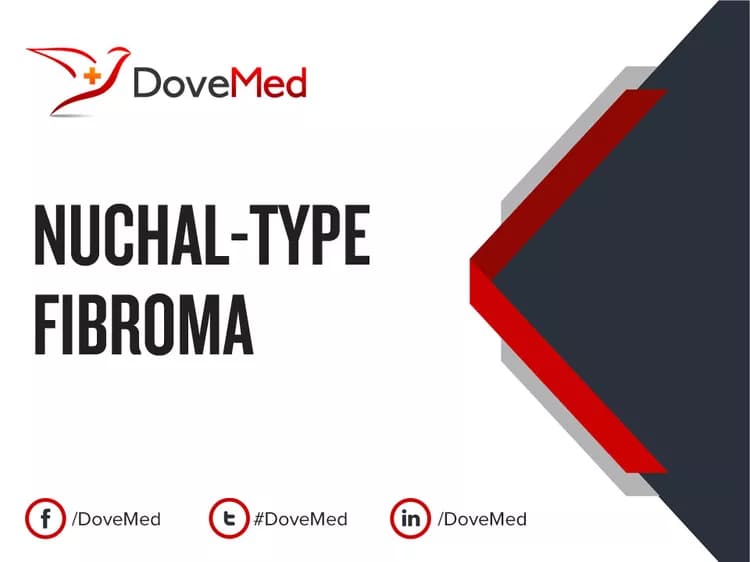What are the other Names for this Condition? (Also known as/Synonyms)
- Collagenosis Nuchae
- NTF (Nuchal-Type Fibroma)
- Nuchal Fibroma
What is Nuchal-Type Fibroma? (Definition/Background Information)
- Nuchal-Type Fibroma (NTF) is a rare and benign accumulation of collagen that presents as a tumor on the nape of the neck (nuchal region), just below the skin
- The cause of Nuchal-Type Fibroma is unknown, but the presence of type 2 diabetes is associated with the tumor in about 50% of the cases
- Generally, there are no significant signs and symptoms or complications observed with Nuchal-Type Fibroma
- A complete surgical excision of Nuchal-Type Fibroma can usually result in a cure. The prognosis with appropriate treatment (surgical removal) is excellent, though tumors are known to recur at a high rate
Who gets Nuchal-Type Fibroma? (Age and Sex Distribution)
- Nuchal-Type Fibroma may occur at any age, though they are mostly seen in the period of 20-50 years
- The tumor is more frequently observed in males than females
- All racial and ethnic groups are at risk and no preference is noted
What are the Risk Factors for Nuchal-Type Fibroma? (Predisposing Factors)
The specific risk factors for Nuchal-Type Fibroma are unknown in over half of the cases. On some tumors, diabetes is known to influence tumor formation and growth:
- Association of Nuchal-Type Fibroma with diabetes is seen; some studies indicate that up to 45% cases may show diabetes mellitus
- There is a histological similarity between diabetic scleredema (a tumor-like lesion that occurs in fibrous tissues due to the presence of diabetes type 2) and NTF. Furthermore, diabetic scleredema sites are the same as NTF (i.e., the neck, upper back, and shoulders)
It is important to note that having a risk factor does not mean that one will get the condition. A risk factor increases ones chances of getting a condition compared to an individual without the risk factors. Some risk factors are more important than others.
Also, not having a risk factor does not mean that an individual will not get the condition. It is always important to discuss the effect of risk factors with your healthcare provider.
What are the Causes of Nuchal-Type Fibroma? (Etiology)
- The cause of Nuchal-Type Fibroma is unknown in most cases
- Although, nearly 50% of these tumors are noted to occur against a background of type 2 diabetes
What are the Signs and Symptoms of Nuchal-Type Fibroma?
The signs and symptoms of Nuchal-Type Fibroma may include the following:
- The presence of a poorly-circumscribed, hard lesion consisting of thick collagen fibers
- The tumors may invade the surrounding skeletal muscles and fat tissues
- The tumor is typically solitary in nature, with a max size of 3 cm (along the larger dimension)
- NTF is typically present on the back of the neck (posterior), but may be seen at other locations too; extra-nuchal tumors are seen in the upper back, limbs, and face
- If NTF is seen along with type 2 diabetes, then the symptoms of diabetes may be present
How is Nuchal-Type Fibroma Diagnosed?
The following are the diagnostic tools for Nuchal-Type Fibroma:
- A thorough physical examination and a complete medical history are very crucial
- Tests to detect diabetes, if present
- Imaging studies including CT or MRI scans of the neck or other affected region
- Tissue biopsy of the tumor: A tissue biopsy is performed and sent to a laboratory for a pathological examination, who examines the biopsy under a microscope. After putting together clinical findings, special studies on tissues (if needed) and with microscope findings, the pathologist arrives at a definitive diagnosis. A tissue biopsy is performed to rule out other types of tumors
Note: Since histologically both nuchal and extra-nuchal tumors are similar, the use of the term Nuchal Fibroma and Nuchal-Type Fibroma includes such tumors found anywhere in the body including the neck.
Many clinical conditions may have similar signs and symptoms. Your healthcare provider may perform additional tests to rule out other clinical conditions to arrive at a definitive diagnosis.
What are the possible Complications of Nuchal-Type Fibroma?
There have been no reports of significant complications due to Nuchal-Type Fibroma.
- However, there may be complications owing to the presence of diabetes
- Most NTF tumors are known to recur following their surgical removal
How is Nuchal-Type Fibroma Treated?
- In some cases, no treatment may be necessary for Nuchal-Type Fibromas, since they are benign in nature. The healthcare provider shall suggest suitable treatment measures in such cases
- When required, a surgical excision of the tumor is considered sufficient treatment. Tumors that occur against a backdrop of diabetes may be removed
- Treatment of underlying diabetes
- Regular follow-up and periodic healthcare visits are advised
How can Nuchal-Type Fibroma be Prevented?
- The cause of Nuchal-Type Fibroma is unknown; hence, currently there are no known methods to prevent the tumor occurrence
- Since, many tumors are influenced by the presence of diabetes, an adequate control of type 2 diabetes can help lower one’s risk for NTF
What is the Prognosis of Nuchal-Type Fibroma? (Outcomes/Resolutions)
- The prognosis of Nuchal-Type Fibroma is excellent on its complete surgical removal
- In many cases, the tumor can recur after surgical excision. However, the tumor is benign and no malignancy is noted
Additional and Relevant Useful Information for Nuchal-Type Fibroma:
Please visit our Cancer & Benign Tumor Health Center for more physician-approved health information:
Related Articles
Test Your Knowledge
Asked by users
Related Centers
Related Specialties
Related Physicians
Related Procedures
Related Resources
Join DoveHubs
and connect with fellow professionals


0 Comments
Please log in to post a comment.